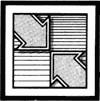 Readers'
Feedback
Readers'
FeedbackThe Editors and Readers of COMPUTE!
Whatever Happened To Compatibility?
I remember reading some time ago about MSX computers which were all supposed to be compatible with each other. Compatibility seems to be a very important consideration. Why didn't these computers sell as well as Apples, Commodores, and Ataris? Also, since Microsoft made both MS-DOS and MSX-DOS, and since the Z80 and 8088 processors are closely related, are IBM computers compatible with MSX computers?
Satoru Fukushima
MSX computers are designed to be compatible with each other, but they have never become a significant factor in the United States market. Had they come to market one year earlier, the story might be very different. However, by the time MSX computers were ready for the U.S. market, that market was already making a dramatic shift away from 8-bit computers toward more powerful 16-bit machines. Despite the obvious attractiveness of a standard that applies to many different computers, it now seems unlikely that the MSX standard will ever become as widespread as many people had once thought.
MSX computers share some similarities with MS-DOS computers (a category that includes the IBM PC/PCjr and compatible machines). Both systems use similar file structures, and the Z80 and 8088 microprocessors have similar instruction sets. However, there are enough differences-especially hardware differencesbetween the two types of computers so that neither machine can read disks or run software created by the other.
If recent developments in 68000-based computers are any indication, you're not likely to see much cross-brand compatibility among 16-bit machines, either. The Apple Macintosh, Commodore Amiga, Atari ST, and Apple. IIGs all use unique operating systems and disk formats. Thus, an Amiga can't run a Mac program, an Apple IIGS can't read ST disks, and so forth. There are superficial similarities in the operating-system interfaces used by these machines-they all use a mouse, menus, windows, and so forth-but they are profoundly different at the level of hardware and system software.